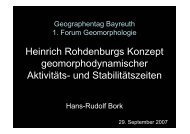Chapter 14 - Limitations on Predictive Modeling in Geomorphology ...
Chapter 14 - Limitations on Predictive Modeling in Geomorphology ...
Chapter 14 - Limitations on Predictive Modeling in Geomorphology ...
Create successful ePaper yourself
Turn your PDF publications into a flip-book with our unique Google optimized e-Paper software.
344 THE SCIENTIFIC NATURE OF GEOMORPHOLOGY<br />
by weight (Johns<strong>on</strong> and Rod<strong>in</strong>e 1984). These flows move under rheological c<strong>on</strong>diti<strong>on</strong>s<br />
(Figure <str<strong>on</strong>g>14</str<strong>on</strong>g>.3) that are dist<strong>in</strong>ct (Johns<strong>on</strong> and Rod<strong>in</strong>e 1984; Ivers<strong>on</strong> and Denl<strong>in</strong>ger 1987)<br />
from the fluvial c<strong>on</strong>diti<strong>on</strong>s that characterize flume studies such as those from which most<br />
bedload formulas are derived. If a fluvial erosi<strong>on</strong> and depositi<strong>on</strong> model were applied at a<br />
locati<strong>on</strong> where debris flow processes are important, then no amount of attenti<strong>on</strong> to<br />
improvement of the fluvial model can account for the effects of a physically dist<strong>in</strong>ct<br />
process.<br />
UNKNOWN INITIAL CONDITIONS<br />
Initial c<strong>on</strong>diti<strong>on</strong>s are statements about a system that must be made before a model can be<br />
implemented. In fluvial transport, these c<strong>on</strong>diti<strong>on</strong>s might <strong>in</strong>clude the distributi<strong>on</strong> of gra<strong>in</strong><br />
sizes, the cohesiveness of bank material, topographic details of the bed, distributi<strong>on</strong> of<br />
channel vegetati<strong>on</strong>, as well as <strong>in</strong>formati<strong>on</strong> about stream flow characteristics. Initial c<strong>on</strong>diti<strong>on</strong>s<br />
also <strong>in</strong>clude the distributi<strong>on</strong> of sediment characteristics with depth below the bed<br />
surface, s<strong>in</strong>ce erosi<strong>on</strong> can expose previously buried material. These c<strong>on</strong>diti<strong>on</strong>s are known<br />
<strong>on</strong>ly approximately, or, <strong>in</strong> some regi<strong>on</strong>s of the system, not at all. In studies of coastal<br />
sediment transport, essentially all models predict<strong>in</strong>g the shoreface profile al<strong>on</strong>g barrierisland<br />
dom<strong>in</strong>ated coastl<strong>in</strong>es assume that the shoreface is composed entirely of loose sand<br />
transportable <strong>in</strong> bedload or suspensi<strong>on</strong>. However, field studies al<strong>on</strong>g the North Carol<strong>in</strong>a<br />
coast (e.g. Riggs et al. 1995, and references there<strong>in</strong>) show the existence of numerous<br />
premodern features of variable cohesiveness and transportability that underlie or breach<br />
the th<strong>in</strong> veneer of sand (typically < 1 m thick) <strong>on</strong> the shoreface. Such sediments range<br />
from marsh peats and tidal flat muds to <strong>in</strong>durated sandst<strong>on</strong>es and gravels. The map shown<br />
<strong>in</strong> Figure <str<strong>on</strong>g>14</str<strong>on</strong>g>.4, based <strong>on</strong> side-scan s<strong>on</strong>ar imag<strong>in</strong>g, shows the distributi<strong>on</strong> of silty sand,<br />
sandy gravel, and bedrock outcrops al<strong>on</strong>g a secti<strong>on</strong> of the coast of North Carol<strong>in</strong>a (Thieler<br />
et al. 1995). <strong>Predictive</strong> capabilities of sediment transport models based <strong>on</strong> the assumpti<strong>on</strong><br />
of a uniform, loose, sandy shoreface are critically impacted wherever exposure of cohesive<br />
units occurs, or where significant changes <strong>in</strong> gra<strong>in</strong> size occur, as <strong>in</strong> the figure. Informati<strong>on</strong><br />
of this type has generally not been available for model studies of the shoreface.<br />
Role of Data Collecti<strong>on</strong><br />
These observati<strong>on</strong>s suggest that as far as predictive power is c<strong>on</strong>cerned, local site-specific<br />
data collecti<strong>on</strong> can be at least as important as model choice or model ref<strong>in</strong>ement.<br />
Improved data collecti<strong>on</strong>, of course, improves knowledge of <strong>in</strong>itial c<strong>on</strong>diti<strong>on</strong>s. More<br />
important is that periodic data collecti<strong>on</strong> can be comb<strong>in</strong>ed with model feedback as a<br />
practical strategy to generate a runn<strong>in</strong>g predicti<strong>on</strong>. In general, predicti<strong>on</strong> of specific<br />
system behavior diverges over time from actual system behavior. Divergence occurs not<br />
<strong>on</strong>ly because of <strong>in</strong>completely known <strong>in</strong>itial c<strong>on</strong>diti<strong>on</strong>s, but also because of the <strong>in</strong>fluence of<br />
all other sources of uncerta<strong>in</strong>ty. Periodic m<strong>on</strong>itor<strong>in</strong>g of the state of the physical system<br />
provides the <strong>in</strong>formati<strong>on</strong> needed to correct the model (reset the <strong>in</strong>itial c<strong>on</strong>diti<strong>on</strong>s) as<br />
required. Reliable predicti<strong>on</strong>s of specific behavior for essentially all large-scale systems<br />
(not just sediment transport systems) require some comb<strong>in</strong>ati<strong>on</strong> of data collecti<strong>on</strong> and<br />
feedback. As the values of system variables beg<strong>in</strong> to diverge from predicted values, data








